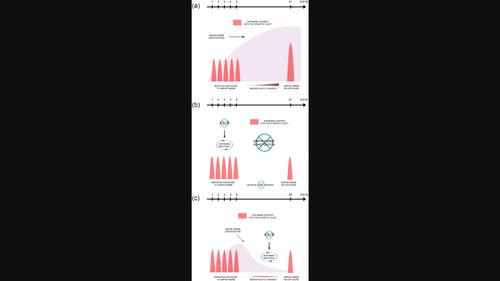当前位置:
X-MOL 学术
›
Eur. J. Nerosci.
›
论文详情
Our official English website, www.x-mol.net, welcomes your feedback! (Note: you will need to create a separate account there.)
Angiotensin II involvement in the development and persistence of amphetamine‐induced sensitization: Striatal dopamine reuptake implications
European Journal of Neroscience ( IF 3.4 ) Pub Date : 2024-03-14 , DOI: 10.1111/ejn.16312 Osvaldo M. Basmadjian 1 , Victoria B. Occhieppo 1 , Antonella E. Montemerlo 2 , Gustavo A. Rivas 2 , María D. Rubianes 2 , Gustavo Baiardi 3 , Claudia Bregonzio 1
European Journal of Neroscience ( IF 3.4 ) Pub Date : 2024-03-14 , DOI: 10.1111/ejn.16312 Osvaldo M. Basmadjian 1 , Victoria B. Occhieppo 1 , Antonella E. Montemerlo 2 , Gustavo A. Rivas 2 , María D. Rubianes 2 , Gustavo Baiardi 3 , Claudia Bregonzio 1
Affiliation

|
Amphetamine (AMPH) exposure induces behavioural and neurochemical sensitization observed in rodents as hyperlocomotion and increased dopamine release in response to a subsequent dose. Brain Angiotensin II modulates dopaminergic neurotransmission through its AT1 receptors (AT1 ‐R), positively regulating striatal dopamine synthesis and release. This work aims to evaluate the AT1 ‐R role in the development and maintenance of AMPH‐induced sensitization. Also, the AT1 ‐R involvement in striatal dopamine reuptake was analysed. The sensitization protocol consisted of daily AMPH administration for 5 days and tested 21 days after withdrawal. An AT1 ‐R antagonist, candesartan, was administered before or after AMPH exposure to evaluate the participation of AT1 ‐R in the development and maintenance of sensitization, respectively. Sensitization was evaluated by locomotor activity and c‐Fos immunostaining. Changes in dopamine reuptake kinetics were evaluated 1 day after AT1 ‐R blockade withdrawal treatment, with or without the addition of AMPH in vitro. The social interaction test was performed as another behavioural output. Repeated AMPH exposure induced behavioural and neurochemical sensitization, which was prevented and reversed by candesartan. The AT1 ‐R blockade increased the dopamine reuptake kinetics. Neither the AMPH administration nor the AT1 ‐R blockade altered the performance of social interaction. Our results highlight the AT1 ‐R's crucial role in AMPH sensitization. The enhancement of dopamine reuptake kinetics induced by the AT1 ‐R blockade might attenuate the neuroadaptive changes that lead to AMPH sensitization and its self‐perpetuation. Therefore, AT1 ‐R is a prominent candidate as a target for pharmacological treatment of pathologies related to dopamine imbalance, including drug addiction and schizophrenia.
中文翻译:

血管紧张素 II 参与安非他明诱导敏化的发生和持续:纹状体多巴胺再摄取的影响
安非他明 (AMPH) 暴露会引起行为和神经化学过敏,在啮齿类动物中观察到,如后续剂量引起的过度运动和多巴胺释放增加。脑血管紧张素 II 通过其 AT 调节多巴胺能神经传递1 受体(AT1 ‐R),正向调节纹状体多巴胺的合成和释放。这项工作旨在评估 AT1 ‐R 在 AMPH 诱导致敏的发生和维持中的作用。另外,AT1 ‐分析了 R 参与纹状体多巴胺再摄取的情况。致敏方案包括每日 AMPH 给药,持续 5 天,并在停药后 21 天进行测试。一个AT1 ‐R 拮抗剂坎地沙坦在 AMPH 暴露之前或之后施用,以评估 AT 的参与1 ‐R 分别参与敏化的发展和维持。通过运动活性和 c-Fos 免疫染色评估致敏性。AT 后 1 天评估多巴胺再摄取动力学的变化1 ‐R 阻断戒断治疗,体外添加或不添加 AMPH。社交互动测试作为另一种行为输出进行。反复暴露于 AMPH 会引起行为和神经化学过敏,坎地沙坦可以预防和逆转这种情况。AT1 ‐R 阻断增加了多巴胺再摄取动力学。无论是 AMPH 管理部门还是 AT1 ‐R 封锁改变了社交互动的表现。我们的结果突出了 AT1 ‐R 在 AMPH 致敏中发挥着至关重要的作用。AT 诱导的多巴胺再摄取动力学增强1 ‐R 阻断可能会减弱导致 AMPH 敏化及其自我延续的神经适应性变化。因此,AT1 ‐R 是药物治疗与多巴胺失衡相关的病理学(包括药物成瘾和精神分裂症)的重要候选靶点。
更新日期:2024-03-14
中文翻译:

血管紧张素 II 参与安非他明诱导敏化的发生和持续:纹状体多巴胺再摄取的影响
安非他明 (AMPH) 暴露会引起行为和神经化学过敏,在啮齿类动物中观察到,如后续剂量引起的过度运动和多巴胺释放增加。脑血管紧张素 II 通过其 AT 调节多巴胺能神经传递



























 京公网安备 11010802027423号
京公网安备 11010802027423号